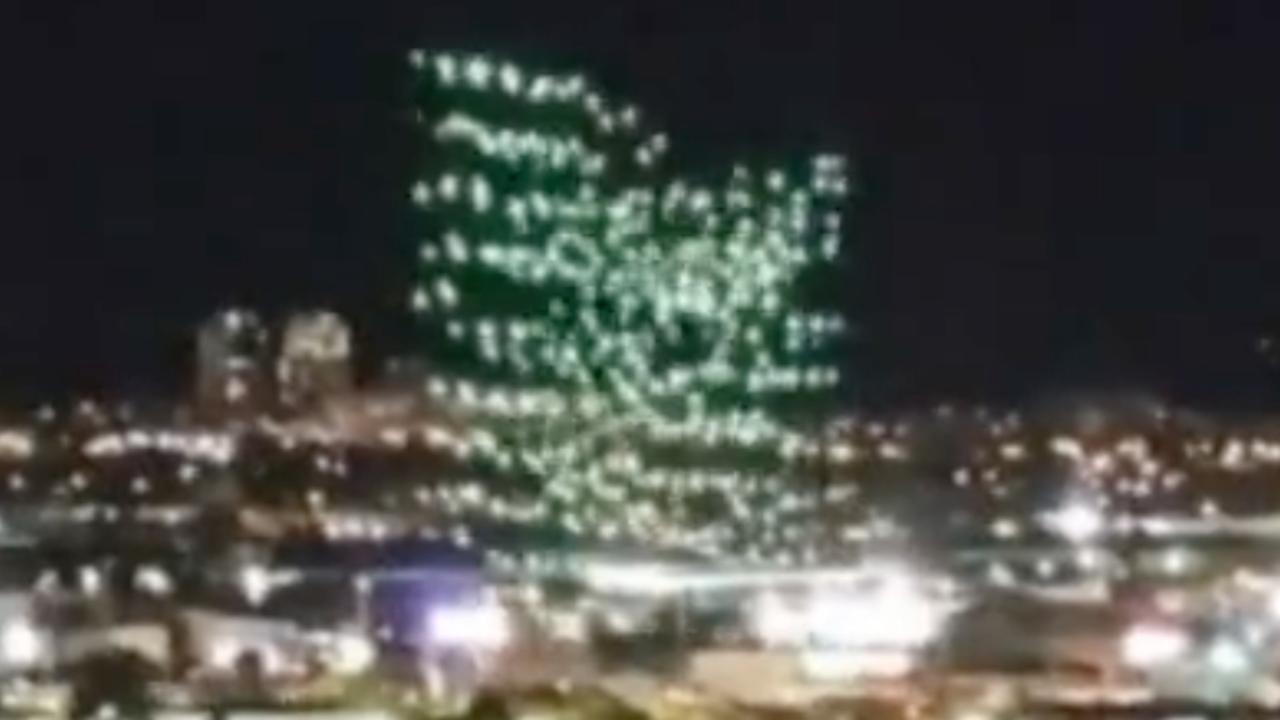Orlando drone show malfunction: The spectacular nighttime drone show over Orlando recently took an unexpected turn, leaving spectators and organizers alike questioning the reliability and safety of large-scale drone displays. This incident serves as a critical examination of the technological challenges and safety protocols surrounding this increasingly popular form of entertainment. We will delve into the technical aspects of the malfunction, explore the immediate impact and response, and ultimately consider the future implications for drone technology and regulations.
From initial eyewitness accounts describing erratic drone movements and mid-air collisions to the subsequent investigation into potential software and hardware failures, the incident raises crucial questions about the safety measures implemented and the preparedness of organizers to handle such unforeseen circumstances. The analysis will explore the various contributing factors, including the role of weather conditions, maintenance schedules, and the overall complexity of coordinating a large fleet of autonomous drones.
Furthermore, we’ll assess the public’s reaction and the potential long-term effects on the perception and regulation of drone technology.
The Orlando Drone Show Malfunction
The recent drone show in Orlando experienced a significant malfunction, resulting in a spectacular, yet concerning, display. This incident highlights the inherent complexities and potential risks associated with large-scale drone operations, prompting a review of safety protocols and technological advancements in the field.
The Orlando Drone Show Incident: Initial Reports
The event, initially planned as a breathtaking aerial spectacle, quickly devolved into a chaotic scene. Reports suggest a cascade of failures began approximately ten minutes into the show, affecting a substantial portion of the participating drones. Eyewitness accounts describe a loss of synchronized flight patterns, with several drones deviating wildly from their programmed routes and exhibiting erratic movements, including uncontrolled descents and collisions.
The timeline of events, based on initial reports, indicates a seemingly normal launch and initial flight sequence, followed by a gradual increase in erratic behavior among the drones. Within minutes, a significant portion of the fleet experienced malfunctions, culminating in a ground stop. Initial eyewitness accounts described a mesmerizing initial display, quickly transitioning into a chaotic scene of flashing lights and unpredictable drone movements.
The initial synchronized patterns dissolved into a jumbled mess of erratically moving drones, some dropping from the sky.
Technical Aspects of the Malfunction
Several potential causes for the drone malfunction are under investigation. Software glitches, including communication failures between the drones and the central control system, are a primary suspect. Hardware failures, such as battery malfunctions or motor issues, are also being considered. A comparative analysis of the drones’ performance before and during the malfunction is crucial to pinpoint the root cause.
The investigation will likely focus on identifying potential points of failure within the drone’s flight control systems, GPS modules, and communication networks.
Safety protocols, including redundancy systems and emergency shutdown mechanisms, are essential for large-scale drone operations. The effectiveness of these protocols during the Orlando incident needs thorough examination. A detailed analysis of the data logs from the drones and the control system will be necessary to determine whether established safety protocols were adequately implemented and if they functioned as intended.
Impact and Response
Fortunately, despite the dramatic nature of the malfunction, reports indicate no significant injuries or major property damage. The quick response of show organizers and local authorities helped to minimize any potential hazards. The immediate halt of the show prevented further incidents, and emergency services were deployed to secure the area. Public reaction varied, with some expressing concern and others viewing the event as a fascinating, albeit unexpected, spectacle.
The organizers issued a public apology and are actively investigating the cause of the malfunction to prevent future occurrences.
Immediate actions taken included a complete ground stop and a thorough assessment of the remaining drones. A detailed investigation into the root cause of the malfunction is underway, including examination of drone hardware, software, and communication systems. The organizers have committed to implementing enhanced safety protocols and undergoing rigorous testing before any future drone shows.
Drone Technology and Safety, Orlando drone show malfunction
The safety of drone operations is paramount, particularly in large-scale displays. Various safety features are available, but their effectiveness varies significantly depending on implementation and environmental factors.
| Safety Feature | Description | Effectiveness | Limitations |
|---|---|---|---|
| Redundant Systems | Backup systems for critical components (e.g., flight controllers, GPS). | High, if properly implemented and tested. | Can add complexity and weight. |
| Emergency Stop Mechanisms | Systems for immediate shutdown in case of malfunction. | High, if reliably activated. | Requires robust communication links. |
| Geo-fencing | Restricting drone flight to a predefined area. | Moderate, can be bypassed. | Requires accurate GPS data and robust software. |
| Obstacle Avoidance | Sensors and algorithms to detect and avoid obstacles. | Variable, depends on sensor technology and environmental conditions. | Can be affected by weather and lighting. |
Regular maintenance and inspections are crucial for ensuring the operational safety of drones. Strict adherence to manufacturer guidelines and rigorous testing before each flight are essential. Regulations and certifications play a vital role in standardizing safety practices and holding operators accountable. Managing large-scale drone shows presents unique challenges, requiring meticulous planning, robust communication systems, and comprehensive safety protocols.
Future Implications
The Orlando incident underscores the need for improved safety protocols in future drone shows. Recommendations include implementing more robust redundancy systems, enhancing communication protocols, and developing more sophisticated emergency response plans. Technological advancements, such as AI-powered autonomous flight control and improved obstacle avoidance systems, can further mitigate risks. The incident may influence public perception of drone technology, potentially leading to increased scrutiny and tighter regulations.
The long-term impact on regulations and guidelines for drone operations is likely to be significant. Expect a renewed focus on safety standards, enhanced training requirements for operators, and stricter enforcement of existing regulations. This incident serves as a valuable lesson, emphasizing the need for continuous improvement in drone technology and safety protocols to ensure the responsible and safe integration of drones into our airspace.
Visual Representation of the Event

Initially, the drones presented a mesmerizing, synchronized display of lights and formations, creating intricate patterns across the night sky. The drones, each equipped with bright LEDs, moved with precision, forming shapes and images that captivated the audience. During the malfunction, this synchronized ballet devolved into chaos. The spatial arrangement of the drones, which had been meticulously planned, broke down as drones deviated from their programmed paths.
The recent Orlando drone show malfunction highlights the inherent risks in large-scale drone displays. Such incidents underscore the importance of robust safety protocols, and understanding the potential for things to go wrong, as illustrated by the information available on drone show accident reports. Ultimately, the Orlando malfunction serves as a reminder of the need for continuous improvement in drone show technology and oversight to prevent future issues.
Some spun uncontrollably, others plummeted toward the ground, while others continued to drift erratically across the sky, their lights flashing erratically.
The overall visual impact was jarring, shifting from a breathtaking spectacle to a chaotic and somewhat frightening scene. The sudden disruption of the carefully choreographed patterns, coupled with the unpredictable movements of the drones, created a sense of disarray and uncertainty among the spectators. The contrast between the initially mesmerizing display and the subsequent chaotic malfunction left a lasting impression, highlighting the potential risks associated with large-scale drone operations.
The Orlando drone show malfunction serves as a stark reminder of the inherent risks involved in large-scale drone operations. While technological advancements continue to push the boundaries of what’s possible, ensuring public safety remains paramount. A thorough investigation, coupled with improved safety protocols and potentially new regulations, are crucial to preventing similar incidents in the future. The incident highlights the need for rigorous testing, robust safety systems, and a proactive approach to risk management within the rapidly evolving field of drone technology.
The recent Orlando drone show malfunction, with its unexpected mid-air pauses and erratic movements, highlights the complexities of large-scale drone displays. This incident prompts reflection on the overall safety and reliability of such events, contrasting perhaps with the smoother operations often seen at other shows, such as those detailed on the florida drone show website. Ultimately, the Orlando incident underscores the need for rigorous testing and contingency planning to prevent future malfunctions.
The event underscores the importance of continuous improvement in both technology and safety procedures to maintain public trust and confidence in drone shows as a form of entertainment.
FAQ Summary
What type of drones were used in the Orlando show?
This information is typically not publicly released immediately following an incident, pending investigation.
Were there any injuries reported?
This detail will be included in official reports following a full investigation.
The Orlando drone show malfunction highlights the inherent risks in large-scale drone displays. Such incidents underscore the importance of rigorous safety protocols, as evidenced by the unfortunate consequences detailed in this report on a drone show accident. Understanding the causes of these failures, whether in Orlando or elsewhere, is crucial for preventing future malfunctions and ensuring public safety.
What was the estimated cost of the damage?
The financial impact will likely be assessed and reported by the organizers and insurers after a complete investigation.
What actions are being taken to prevent future malfunctions?
Expect improved safety protocols, enhanced maintenance procedures, and potentially stricter regulations to be implemented.

